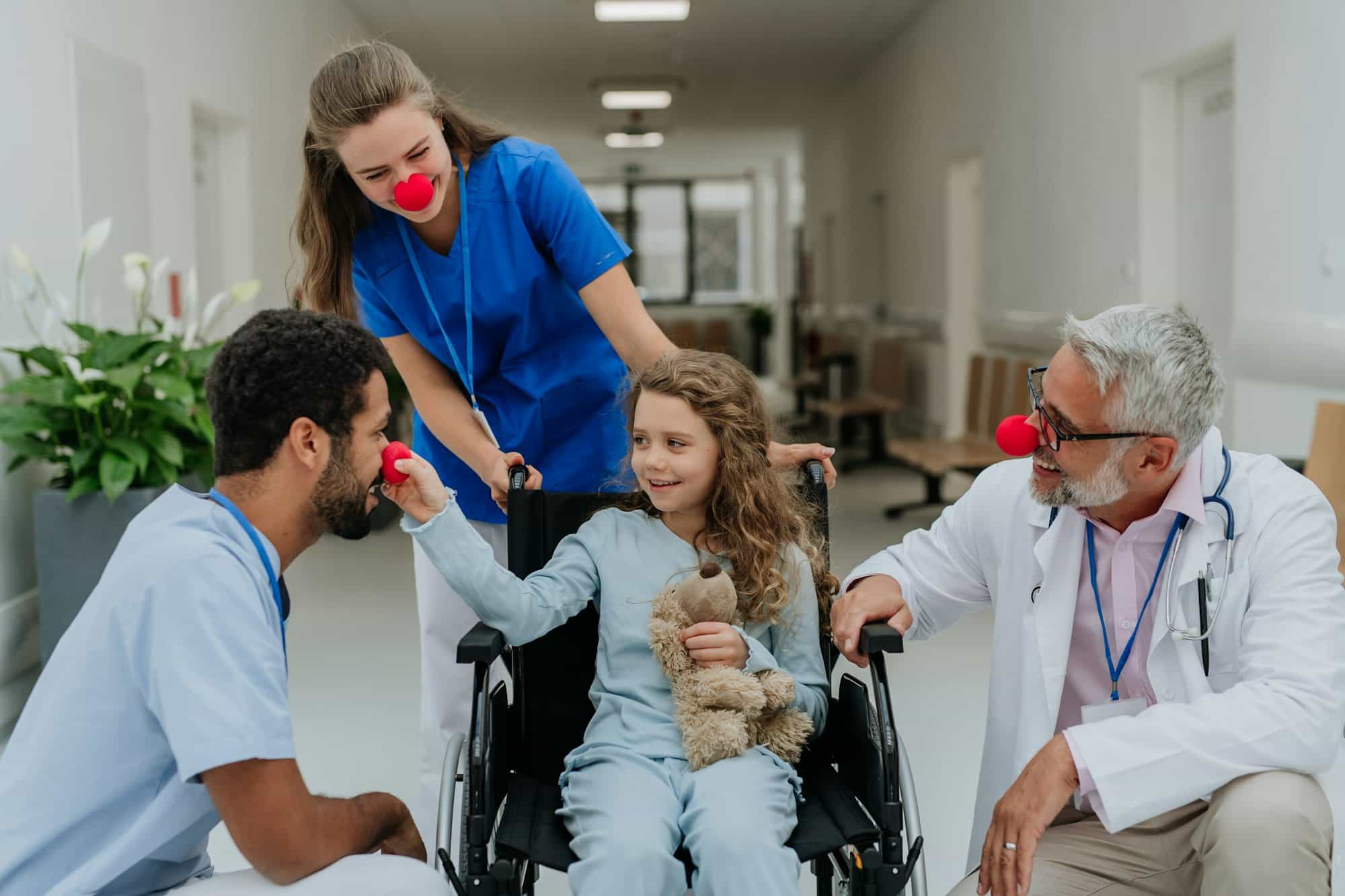For many children, hospitals are places of anxiety, fear, and discomfort. The sterile rooms, unfamiliar faces, and intimidating medical equipment can be frightening. There’s a need to humanize this environment, especially for pediatric patients. One method that has been receiving increased attention is therapeutic clowning. This involves professional performers using humor and play to alleviate anxiety and pain in children in hospitals.
Understanding Children’s Anxiety in Hospitals
Children’s anxiety in hospitals is a matter of critical concern. It’s not just about the immediate discomfort. High levels of anxiety can potentially interfere with the child’s recovery process and overall coping mechanism.
Cela peut vous intéresser : Can Interactive Voice Response Systems Enhance Medication Adherence Among the Elderly?
According to a paper published on PubMed, children’s anxiety in hospitals is associated with a variety of factors. These may include fear of the unknown, separation from parents, and anticipation of pain. These factors can lead to changes in behavior, increased heart rate, and higher blood pressure levels.
The Google Scholar database lists many studies indicating that child anxiety in hospitals is a global issue. However, various approaches have been undertaken to address this issue. Among these, the use of therapeutic clowning has been noted as a promising intervention.
Cela peut vous intéresser : What Are the Psychosocial Effects of Facial Transplant Surgery on Recipients?
The Role of Clowning in Pediatric Care
In the realm of pediatric care, clowns are not just performers; they play a crucial role in the well-being of patients. They utilize humor and play to create a joyful ambiance, diverting the child’s attention from their medical condition.
This clowning intervention is not just about telling jokes or performing tricks. The clowns use a variety of techniques, including magic, storytelling, music, and puppetry, to engage with the children. They also adapt their approach based on the individual child’s age, medical condition, and personality.
A group of studies available on PubMed has shown that therapeutic clowning can help reduce anxiety levels in children awaiting surgical procedures. In addition, these studies suggest that it can also help decrease the need for sedation and improve cooperation during medical procedures.
Evaluating the Impact of Clowning on Children’s Hospital Anxiety
To understand the magnitude of the impact of therapeutic clowning on pediatric patient anxiety, several studies have been conducted.
A study published on PubMed examined the effect of clown intervention on anxiety and pain levels in children undergoing minor surgeries. The results demonstrated that the children who interacted with the clowns reported significantly lower levels of anxiety and pain compared to the control group.
In another study documented on Google Scholar, it was found that therapeutic clowning had a positive effect on children undergoing invasive procedures. The children who were exposed to therapeutic clowning showed a significant decrease in anxiety levels and an increase in overall satisfaction with their hospital care.
Such studies strongly indicate that clowning intervention can have a substantial impact on reducing hospital-induced anxiety in children.
Parents’ Perspectives on Therapeutic Clowning
Undeniably, the parents’ perspective plays an essential role when it comes to pediatric care. A hospital stay can be as stressful for the parents as it is for the child. Therefore, understanding their viewpoint is crucial.
A group of studies explored parents’ perspectives on the use of therapeutic clowning. The majority of parents reported that the clowns had a positive impact on their child’s anxiety levels. They observed that their children appeared more cheerful and less anxious after interacting with the clowns.
Parents also reported feeling more at ease seeing their children happy and engaged. Therefore, therapeutic clowning not only eases the child’s anxiety but also provides comfort to the parents.
The Broader Implications of Therapeutic Clowning in Health Care
While the primary focus of therapeutic clowning is on children, it’s important to note that its benefits extend to other areas of health care as well. This intervention can be used to alleviate anxiety and fear in adult patients and can also serve as an effective tool for distraction during uncomfortable or painful procedures.
Studies available on PubMed show that therapeutic clowning can be beneficial for elderly patients, often helping to reduce feelings of loneliness and enhance overall well-being.
Furthermore, the positive and joyful environment created by the clowns can also have a beneficial effect on the hospital staff, contributing to improved job satisfaction and decreased stress levels.
In conclusion, therapeutic clowning has proven to be an effective intervention for reducing anxiety, alleviating pain, and enhancing overall well-being in pediatric patients. With the increasing recognition of its benefits, it is clear that it will continue to play a significant role in pediatric care, contributing to more humanized and child-friendly hospitals.
Clown Intervention: A Comprehensive Analysis
Clown intervention, a form of therapeutic clowning, is gaining recognition as a significant strategy in alleviating pediatric patient anxiety in hospital settings. This approach involves professional performers, known as medical clowns, who employ various forms of entertainment to ease the stress and discomfort experienced by children during hospital stays.
A clear understanding of the effect of clown intervention on pediatric patient anxiety requires an elaborate evaluation of existing research. A study published on PubMed revealed that children undergoing minor surgeries, who were exposed to clown intervention, reported significantly lower levels of anxiety and pain. Essentially, it was demonstrated that the use of medical clowns before and during the procedures helped to create a relaxed atmosphere, significantly reducing preoperative anxiety and postoperative pain in the pediatric patients.
Google Scholar details another study where children undergoing invasive procedures were exposed to therapeutic clowning. The study’s findings were significant, confirming that exposure to clown intervention led to a notable decrease in anxiety levels among the children. In addition, these children also exhibited higher levels of satisfaction with their overall hospital care.
These studies, together with numerous others on PubMed and Google Scholar, underscore the positive impact of clown intervention on hospital-induced anxiety. The garnered results clearly illustrate that clown intervention significantly contributes to reducing fear and anxiety among hospitalized children.
The Influence of Clown Therapy: Parental Observations and Beyond
The effectiveness of clown therapy is not only reflected in the findings of the scientific studies but also in the feedback provided by parents of pediatric patients. The parental perspective forms an integral part of the evaluation process, as their observations often provide valuable insights into the patient’s well-being.
Various studies exploring the parents’ perspectives on therapeutic clowning revealed that interaction with hospital clowns significantly improved their child’s mood. Parents reported that their children appeared happier and less anxious after spending time with the clowns. Additionally, parents also noted a sense of relief and comfort, observing their children engaged in joyful activities with the clowns.
However, the benefits of clown therapy extend beyond pediatric wards. For instance, research on PubMed shows that elderly patients can also benefit from therapeutic clowning. The presence of clowns in health care settings can help alleviate feelings of loneliness among the elderly, significantly enhancing their overall well-being.
Furthermore, the positive environment fostered by clown intervention also has a beneficial impact on the hospital staff. The jovial atmosphere created by the clowns contributes to improved job satisfaction and decreased stress levels among medical practitioners.
Conclusion
In light of the significant body of research from reputable sources such as PubMed and Google Scholar, it’s clear that therapeutic clowning has a profound impact on reducing anxiety, minimizing pain, and improving overall well-being among pediatric patients. The feedback from parents and the extended benefits to elderly patients and hospital staff further underscore the importance and effectiveness of clown therapy.
Given the increasing global recognition of therapeutic clowning in health care, medical clowns are set to continue playing a pivotal role in creating child-friendly hospital environments. This development not only benefits the children but all those involved in the health care process, heralding a new era in the humanization of hospitals.






